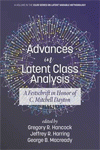
Advances in Latent Class Analysis
A Festschrift in Honor of C. Mitchell Dayton
Edited by:
Gregory R. Hancock, University of Maryland
Jeffrey R. Harring, University of Maryland
George B. Macready, University of Maryland
A volume in the series: CILVR Series on Latent Variable Methodology. Editor(s): Gregory R. Hancock, University of Maryland.
Published 2019
What is latent class analysis? If you asked that question thirty or forty years ago you would have gotten a different answer than you would today. Closer to its time of inception, latent class analysis was viewed primarily as a categorical data analysis technique, often framed as a factor analysis model where both the measured variable indicators and underlying latent variables are categorical. Today, however, it rests within much broader mixture and diagnostic modeling framework, integrating measured and latent variables that may be categorical and/or continuous, and where latent classes serve to define the subpopulations for whom many aspects of the focal measured and latent variable model may differ.
For latent class analysis to take these developmental leaps required contributions that were methodological, certainly, as well as didactic. Among the leaders on both fronts was C. Mitchell “Chan” Dayton, at the University of Maryland, whose work in latent class analysis spanning several decades helped the method to expand and reach its current potential. The current volume in the Center for Integrated Latent Variable Research (CILVR) series reflects the diversity that is latent class analysis today, celebrating work related to, made possible by, and inspired by Chan’s noted contributions, and signaling the even more exciting future yet to come.
CONTENTS
Preface. Biographic Sketch of Chauncey Mitchell Dayton. Acknowledgments. On the Measurement of Noncompliance Using (Randomized) Item Response Models, Ulf Böckenholt, Maarten Cruyff, Peter G. M. van der Heijden, and Ardo van den Hout. Understanding Latent Class Model Selection Criteria by Concomitant-Variable Latent Class Models, José G. Dias. Comparison of Multidimensional Item Response Models: Multivariate Normal Ability Distributions Versus Multivariate Polytomous Ability Distributions, Shelby J. Haberman, Matthias von Davier, and Yi-Hsuan Lee. Nonloglinear Marginal Latent Class Models, Jacques A. Hagenaars, Wicher Bergsma, and Marcel Croon. Mixture of Factor Analyzers for the Clustering and Visualization of High-Dimensional Data, Geoffrey J. McLachlan, Jangsun Baek, and Suren I. Rathnayake. Multimethod Latent Class Analysis, Fridtjof W. Nussbeck and Michael Eid. The Use of Graphs in Latent Variable Modeling: Beyond Visualization, Frank Rijmen. Logistic Regression With Floor and Ceiling Effects: Fixed and Random Effects Models, David Rindskopf and Patrick E. Shrout. Model Based Analysis of Incomplete Data Using the Mixture Index of Fit, Tamás Rudas, Emese Verdes, and Juraj Medzihorsky. A Systematic Investigation of Within-Subject and Between-Subject Covariance Structures in Growth Mixture Models, Junhui Liu and Jeffrey R. Harring. Latent Class Scaling Models for Longitudinal and Multilevel Data Sets, Jeroen K. Vermunt. Modeling Structured Multiple Classification Latent Classes in Multiple Populations, Xueli Xu and Matthias von Davier. About the Editors.
-
Paperback9781641135610
Web price: $45.04 (Reg. 52.99)
-
Hardcover9781641135627
Web price: $80.74 (Reg. 94.99)
- eBook9781641135634

- EDU027000 - EDUCATION: Statistics
- EDU029030 - EDUCATION: TEACHING METHODS & MATERIALS: Science & Technology
- EDU030000 - EDUCATION: Testing & Measurement
-
 Advances in Longitudinal Methods in the Social and Behavioral Sciences
Advances in Longitudinal Methods in the Social and Behavioral Sciences
-
 Advances in Multilevel Modeling for Educational Research
Addressing Practical Issues Found in Real‐World Applications
Advances in Multilevel Modeling for Educational Research
Addressing Practical Issues Found in Real‐World Applications
-
 Continuous Improvement
A Leadership Process for School Improvement
Continuous Improvement
A Leadership Process for School Improvement
-
 Digital Technologies and Early Childhood in China
Policy and Practice
Digital Technologies and Early Childhood in China
Policy and Practice
-
 Effectively Using Data for Educator Preparation Program Improvement
Effectively Using Data for Educator Preparation Program Improvement
-
 Teaching and Learning Online
Science for Secondary Grade Levels
Teaching and Learning Online
Science for Secondary Grade Levels
-
 Unveiling the Cloak of Invisibility
Why Black Males are Absent in STEM Disciplines
Unveiling the Cloak of Invisibility
Why Black Males are Absent in STEM Disciplines

